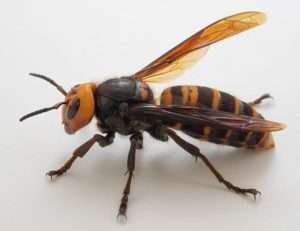
I recently found out that Vespa mandarinia, dubbed by American media as murder hornets,(1) will now have a new common name, thanks to the American Entomological Society. It’s now known as the northern giant hornet, with a southern giant hornet counterpart in the slightly smaller Vespa soror.
These large wasps–the largest in the world, in fact–hit the news back in 2019 when specimens were found in extreme northwestern Washington. They’re native to many areas in Asia, and like other wasps they prey on other insects. Much has been made of how aggressively they can attack honeybees (which also aren’t native here) in order to steal the larvae for food. And, of course, they present a threat to native insects, which already face pressure from other invasive wasps. (Plus no one here wants to find out firsthand what it’s like to be stung by the world’s largest wasp, regardless of whether they’re allergic or not.)
So why is the new name news?
“Murder Hornets” is Overly Sensationalistic
While the ecological and economic concerns over this invasive species are real, the degree has been overblown. Which is par for the course at a time when many news sources are competing for our attention with increasingly sensational headlines (whether they work or not.)

Not only are people working themselves up to unnecessary levels of anxiety about these insects, but they’re taking it out on other species as well. Sales of wasp and hornet spray went up as the news spread, and conservation officials reported an increase in people killing other wasps in cases of mistaken identity. That included numerous native wasps, which are integral parts of their ecosystems (never mind any other insects that happened to come in contact with the spray residues.) Even non-wasps like flies, beetles, and bumblebees were often mistaken for V. mandarinia. Given that insect populations have dropped dramatically worldwide just in the past few decades, we don’t need to give people yet another excuse to go killing them for no reason.
“Asian Giant Hornets” is Too Vague
Besides murder hornets, Asian giant hornet is another common name applied to this species. As mentioned above, there’s another hornet species native to Asia that’s just slightly smaller than V. mandarinia. Add in that there are several other hornet species native Asia, and it becomes quickly apparent that the name is absurdly nondescript.
Granted, “northern giant hornet” isn’t the most exciting name, either, especially compared to “murder hornet”. But it is a more accurately descriptive one, all told.
Xenophobia Isn’t Cool, Y’all
The news about V. mandarinia broke shortly after the COVID-19 pandemic started. Incidences of anti-Asian hate crimes and other xenophobia ramped up on the part of people looking for someone to blame–or just wanting a justification for their prejudices. Given that the United States has a long history of anti-Asian bigotry, this was sadly nothing new.
I’d like to say that my fellow Americans know enough to differentiate between the fact that a natural phenomenon just happened to arise in a particular place, and the people who also just happen to live in the same place. Unfortunately, as I saw firsthand on entirely too many Facebook comment threads, some of them seemed determined to prove me wrong. There are still to this day people insisting on calling COVID “the China virus” or “China flu”, and more than a few of them are convinced it was deliberately released into the world on purpose by a lab in Wuhan in spite of evidence clearly pointing toward an accidental zoonotic transmission in a marketplace. (Which still is no excuse for violence against Chinese people or Asian-Americans, of course.)

But what about the no-longer-known as murder hornets? The scientist who led the campaign to change this insect’s name had personally heard people make comments like “another damn thing from China” (in spite of the fact that Japan is more likely to be the source of the hornets that made it to this side of the Pacific.) While anti-Asian violence is more likely to be justified in some peoples minds by COVID than hornets, anything that helps reduce the stigma is, to my mind, a good thing. Plus it takes very little effort to just call the hornets by another name, and it’s a small gesture of goodwill toward people who have already been dealing with entirely too much bigotry.
So, About Those Hornets…
Aside from a name change, V. mandarinia hasn’t been popping up in U.S. news as much lately. The last nests in Washington seem to have been found in 2021, and scientists have set up a thousand traps to see if there are more hornets still out there. While absence of evidence doesn’t automatically mean evidence of absence, the nests last year were found after individual hornets were trapped. Only time will tell whether we managed to head off an invasive species before it had a chance to get a foothold here. Given that there are already over 6,000 invasive species here, and they tend to be very difficult to eradicate once established, being able to prevent one more would be a cause for celebration.
- Yes, I promised last week I was going to write about something besides invasive species soon. I actually had another topic picked out for today, and then this happened. Hang in there; I DO have other interests, I swear!
